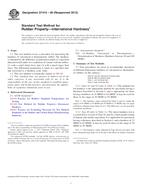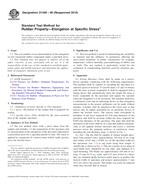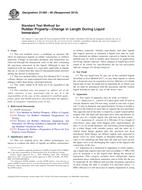We need your consent to use the individual data so that you can see information about your interests, among other things. Click "OK" to give your consent.
ASTM D1415-06(2012)
Standard Test Method for Rubber Property—International Hardness
STANDARD published on 1.1.2012
The information about the standard:
Designation standards: ASTM D1415-06(2012)
Note: WITHDRAWN
Publication date standards: 1.1.2012
SKU: NS-17214
The number of pages: 7
Approximate weight : 21 g (0.05 lbs)
Country: American technical standard
Category: Technical standards ASTM
The category - similar standards:
Annotation of standard text ASTM D1415-06(2012) :
Keywords:
Rubber property analysis, Hardness (indentation)--rubber, Hardness tests, ICS Number Code 83.060 (Rubber)
Additional information
| Significance and Use | ||||||||||||||||||
|
The International Hardness test is based on measurement of the penetration of a rigid ball into the rubber specimen under specified conditions. The measured penetration is converted into IRHD, the scale of degrees being so chosen that 0 represents a material having an elastic modulus of zero, and 100 represents a material of infinite elastic modulus. The scale also fulfills the following conditions over most of the normal range of hardness: one IRHD range represents approximately the same proportionate difference in Young's modulus, and for rubber vulcanizates in the usual range of resilience, readings in IRHD are comparable with those given by a Type A durometer (Test Method D2240) when testing standard specimens. The term “usual range of resilience” is used to exclude those compounds that have unusually high rates of stress relaxation or deformational hysteresis. For such compounds, differences in the dwell time in the two hardness tests (Test Methods D2240 and D1415) result in differences in hardness values. Readings may not be comparable when testing curved or irregularly shaped test specimens. For substantially elastic isotropic materials like well-vulcanized natural rubbers, the hardness in IRHD bears a known relation to Young's modulus, although for markedly plastic or anisotropic rubbers the relationship will be less precisely known. The relation between the difference of penetration and the hardness expressed in IRHD is based on the following: The relation between penetration and
Young's modulus for a perfectly elastic isotropic material:
Use of a probit (integrated normal error) curve to relate log10 M and hardness in IRHD, as shown in Fig. 1. This curve is defined as follows: The value of log10 M corresponding to the midpoint of the curve is equal to 0.364, that is, M = 2.31 MPa or 335 psi. The maximum slope is equal to 57 IRHD per unit increase in log10 M.
|
||||||||||||||||||
| 1. Scope | ||||||||||||||||||
|
1.1 This test method covers a procedure for measuring the hardness of vulcanized or thermoplastic rubber. The hardness is obtained by the difference in penetration depth of a specified dimension ball under two conditions of contact with the rubber: (1) with a small initial force and (2) with a much larger final force. The differential penetration is taken at a specified time and converted to a hardness scale value. 1.2 This test method is technically similar to ISO 48. 1.3 This standard does not purport to address all of the safety concerns, if any, associated with its use. It is the responsibility of the user of this standard to establish appropriate safety and health practices and determine the applicability of regulatory limitations prior to use. |
||||||||||||||||||
| 2. Referenced Documents | ||||||||||||||||||
|
||||||||||||||||||
Similar standards:
Historical
1.1.2010
Historical
1.1.2010
Historical
1.1.2014
Historical
1.5.2012
Historical
1.5.2012
Historical
15.5.2014
We recommend:
Technical standards updating
Do you want to make sure you use only the valid technical standards?
We can offer you a solution which will provide you a monthly overview concerning the updating of standards which you use.
Would you like to know more? Look at this page.



 ASTM D1456-86(2010)..
ASTM D1456-86(2010).. ASTM D1460-86(2010)..
ASTM D1460-86(2010).. ASTM D1566-14
ASTM D1566-14 ASTM D1630-06(2012)..
ASTM D1630-06(2012).. ASTM D1646-07(2012)..
ASTM D1646-07(2012).. ASTM D1871-04(2014)..
ASTM D1871-04(2014)..
 Cookies
Cookies
